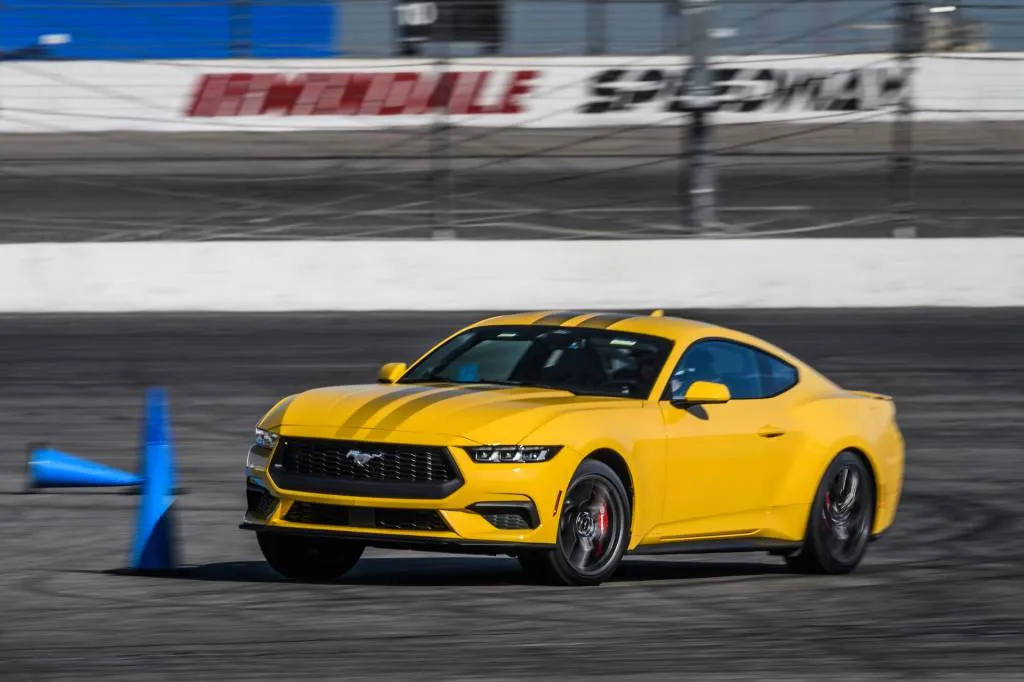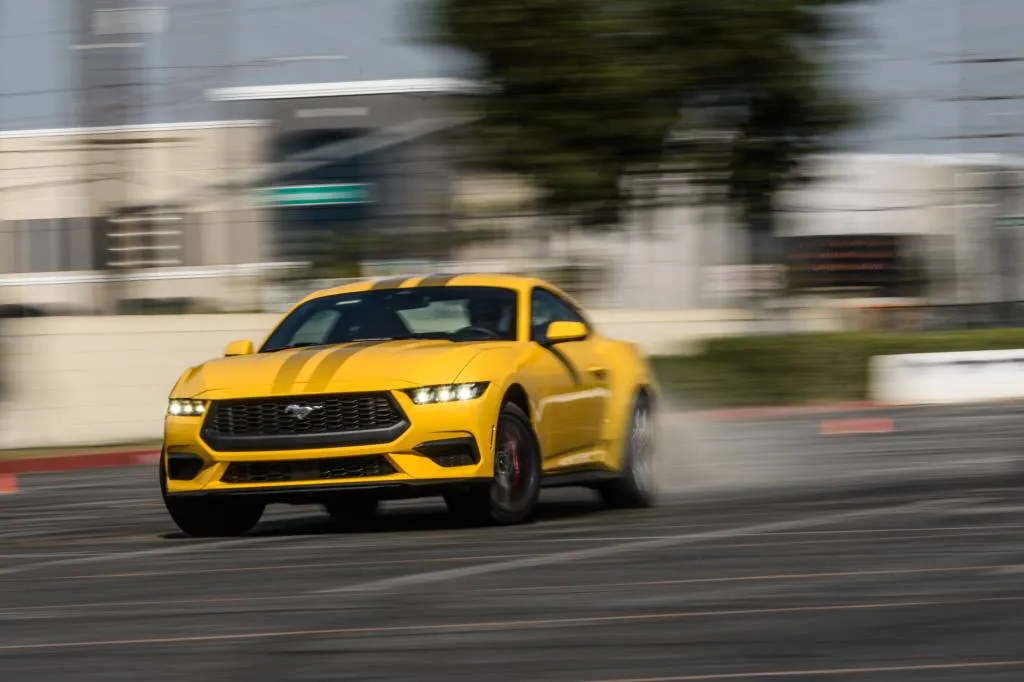2024 Ford Mustang EcoBoost Adds Technology, Keeps The Essentials
Feeding the beans along the Big Tujunga Highway in the Angeles National Forest of Southern California, this 2024 Ford Mustang EcoBoost is familiar, but different. The 7th generation Mustang doesn’t change the dynamics much, but it does add more technology to the experience behind the wheel.
Known internally as the S650, the 7th-generation Mustang looks little different from the previous-generation S550 version.
That’s fine, because I felt the S550-generation Mustang graduated from a pony car to a sports car, especially with the 2018 update that better organized the independent rear suspension that was added to the debut of the 2014 model year S550.
2024 Ford Mustang Ecoboost

2024 Ford Mustang Track theme and custom mode screen

2024 Ford Mustang Fox Body ’87-’93 Theme

2024 ford mustang truck app
2024 Ford Mustang: screens galore
of 2024 Ford Mustang As an evolution of the S550, it has a new exterior design with Chevrolet Camaro touches, especially the more pronounced rear haunches. But the big change is under the hood, with the traditional double binnacle instrument cluster being replaced by a bank of screens that serve more than just a tech hub.
A 12.4-inch digital instrument cluster and 13.2-inch touchscreen stretch out in front of the driver, alongside the retro-inspired cabin. The Sync 4 infotainment system has double the processing power of his Sync 3 system on its predecessor, and the screen uses his Unreal Engine graphics that serve as the backbone of many popular first-person shooters. The system can be updated automatically over the air or on a schedule.
ran through a lot System features After previewing it at Ford headquarters in March, I can say that experiencing it now has enriched the overall Mustang experience. The instrument cluster can be set to his five themes of the driver’s choice: Normal, Sport, Track, Fox Body ’87-’93, and Calm. The track theme represents a hockey-his-stick tachometer like those found on many supercars, and sport mode shows speedometer and tachometer graphs that curve from bottom to top. The Fox Body is a digital representation of the analog gauges of the late 3rd generation Mustang.
I’m driving by the Fox Body theme because I need to give props to the Mustang that inspired Vanilla Ice to introduce 5.0.
In most cases the cluster theme matches the drive mode, but there is no calm drive mode (shouldn’t exist on the Mustang). Ford is also adding Drag Strip, Slippery and Programmable Custom Modes. All Mustangs have a full range of drive modes, and even the relatively tame EcoBoost offers a toy box of performance features to choose from.
All of this is easily accessible via the MyMustang button in the center stack. A screen appears that allows the driver to program custom drive modes, display auxiliary gauges, choose from four available active exhaust sound settings, select a cluster theme, set ambient lighting color and, most importantly, access Track Apps performance features.
The Track app allows drivers to monitor telemetry such as braking distance, acceleration and lap times. This is also where the driver launches his controls, the line lock, the new electronic parking brake that Ford calls the Drift Brake, and the rev-matching feature on his GT with manual transmission.
But this is a lightly-equipped EcoBoost model, and I’m driving with a car-sick journalist. He’ll probably be thrilled to try out these features, so I’ll save his sophomore fun for his GT with his performance package.

2024 Ford Mustang Ecoboost

2024 Ford Mustang Ecoboost

2024 Ford Mustang Ecoboost
2024 Ford Mustang EcoBoost: Classification and Management
Though less obvious than the new Mustang’s tech suite, the mechanical changes are mostly for the better, but it all starts with the same stiff, well-organized platform as the previous car.
Steering is the most noticeable dynamic difference. The steering column is stiffer, the rubber bushings have been removed for a more direct feel, and the ratio has been slightly quickened from 16.0:1 to 15:5.1. The aim was to provide a (slightly) quicker response and more road feel. In the process, Ford also lightened the steering weight, but with too many small modifications, it feels too light for this canyon road. I have it in sport mode, which also has a heavier “sporty” feel. The choices here seem to be light, light, and lightest. I wish Ford would add a setting to make the wheels more stable.
I ride an EcoBoost premium model with a square set of 255/40R19 Continental ProContact all season tires. The car is devoid of any of the performance goodies available, including the $1,750 magnetic dampers, Pirelli P Zero PZ4 summer performance tires, strut tower braces, large rear stabilizer, 3.55 Torsen limited slip rear axle, drift brakes, heavy duty front springs, large brakes with front Brembo calipers, paddle shifters and a $3475 performance package that adds a rear wing spoiler.
Keeping the basics of Mustang’s rear-wheel drive architecture intact, the car performs well here. Despite the low steering weight, the car responds instantly to steering inputs and the wheels tell you what’s happening on the road. The tires offer just enough grip to keep you from skidding in corners, even on a particularly brisk 6-mile stretch of winding road while your driving partner waits at the rest stop.
Approaching corners, the car’s base brakes (a set of four 12.6-inch rotors with two-piston front and single-piston rear calipers) pick up surprisingly well. The brake pedal has a solid, progressive feel and maintains the same resistance throughout the drive. You can’t leave him sitting there squeezing the brakes for too long, and I wouldn’t trust these brakes in those conditions or circuits, but they are more than enough for the chastisement expected of Mustang buyers who choose the base suspension.
Like all Mustangs, this car has new dampers, but they have been adjusted to behave almost identically to the S550 model. Each configuration is optimized for the new steering and selected tire and brake package.
The dampers provide good control of body tilt, providing plenty of feedback from the road and contributing to a firm ride that doesn’t get into the roughest conditions. Everything ties together well and the handling balance in corners is good. Yes, you can kick the rear end out, but it requires a concerted effort or drifting use of his brakes (more on that later).
You’ll hear a lot of tire hum on rough roads like this, but the cacophony of sounds is also part of the Mustang experience. Under the hood is his next-generation 2.3-liter Turbo 4 engine, so tire noise is less noticeable. Sometimes authoritative, crude, monotonous mezzo-soprano tunes are sung. But he’s always upbeat, which matches the Mustang’s extroverted personality.
This engine is the fourth generation of the 2.3-liter Turbo 4 that Ford almost comically calls the Ecoboost (perhaps the “eco” part made more sense 14 years ago when EVs were little thought of in the auto industry). DOE loan Aimed at downsizing and turbocharging the Ford engine). This change makes it more powerful and more efficient at the same time. Equipped with a new twin-scroll turbocharger, it scrolls up faster. In addition, port injection has been added to the conventional direct injection to improve power output and fuel efficiency. This modifies boost power slightly, adding 5 horsepower for a total of 315 horsepower, while torque remains constant at he 350 lb-ft.
I consider the 2.3 to be Mustang’s consolation prize. It’s perfectly capable and gets the job done with a little flair, but the one I’d love to win in the showcase showdown is the GT model Coyote 5.0-liter V-8.
I feel the same way about the fact that EcoBoost is only paired with a 10-speed automatic. It’s a good transmission, but not nearly as enjoyable as his 6-speed manual, which was traditionally available in his EcoBoost.
The powertrain performs well even in these hilly terrain. Sport mode generally keeps the revs high, and the track does an even better job of having power readily available on corner exits. The truck sometimes downshifts mid-corner, slightly affecting the car’s balance. Not so much that it disturbs the line, but using the paddle shift, which only comes with the Performance package, helps prevent that. The car gains speed steadily from curve to curve. Acceleration from 0-90 mph is in the low to mid-fives, and it’s fast and peppy, but not as powerful as the V8 engine.

2024 Ford Mustang Ecoboost

2024 Ford Mustang Ecoboost

2024 Ford Mustang Ecoboost
2024 Ford Mustang EcoBoost: Drifting Made Easy
Earlier in the day, I had the chance to test one of the new Mustang’s party tricks. Drift brake developed with professional drifter Vaughan Gittin Jr.. Drift brakes included in the EcoBoost or GT performance package are essentially premium electronic parking brakes with more than an on and off setting. Similar to a manual parking brake, the harder you pull on the steering wheel, the more braking force is applied to the rear wheels. Its steering wheel rises from the center console and is elbow-shaped for easy access by the driver.
Ford’s controlled exercises for testing drift brakes are as rudimentary as possible. This consists of one of his 180 degree turns and a vertical slide into the stop box.
Your instructor will show you the proper techniques for guiding and controlling your car through switchback turns. It’s similar to Scandinavian flicks and goes like this: Steer to the left, steer slightly to the right to send momentum in that direction, pull the brake, step on the throttle, release the brake at the same time to induce drift, hold the throttle until you’re about to turn in the opposite direction, loosen your hands, and go.
All of this is easier said than done, and easy to go wrong at some points. It’s easy to steer left, but it’s also easy to steer too far right and the car spins instead of drifting. This is compounded by another problem of forgetting to release the brake when pressing the accelerator. It just leads to a spin of about 240 degrees and stops me looking the wrong way. Crack it 10 times and he’ll probably get it right twice and get a perfect 540 the third time and feel pretty cool. However, I think it’s annoying for instructors.
A technique for stopping at 90 degrees is to steer slightly to the right to set momentum and just pull the brakes. However, even here, oversteer and overrotation are more likely to occur. This is the kind of maneuver that looks cool in a TikTok video, but it’s not a smart way to park, especially when there are other cars around.
Nevertheless, with regular parking brakes becoming a thing of the past, the Mustang’s Drift Brake brings back some forgotten fun to your car. It can also be used as a normal parking brake. Stop the car, pull the steering wheel, and look for the “brake” light on the instrument panel to turn off the car. To restart the engine, push the handle down to release the brake.
Drift brakes are just one way the 2024 Ford Mustang blends technology and performance, and the big new screen is more obvious. All this combined with the controlled prowess of a largely carried-over platform to bring the pony car icon into the modern age without losing its sporty essence. Give me some beans if you can.
Ford paid for travel and lodging expenses to the Motor Corporation to deliver this direct report.
https://ift.tt/SCQ6HMi 2024 Ford Mustang EcoBoost Adds Technology, Keeps The Essentials
Auto Updates
Comments
Post a Comment